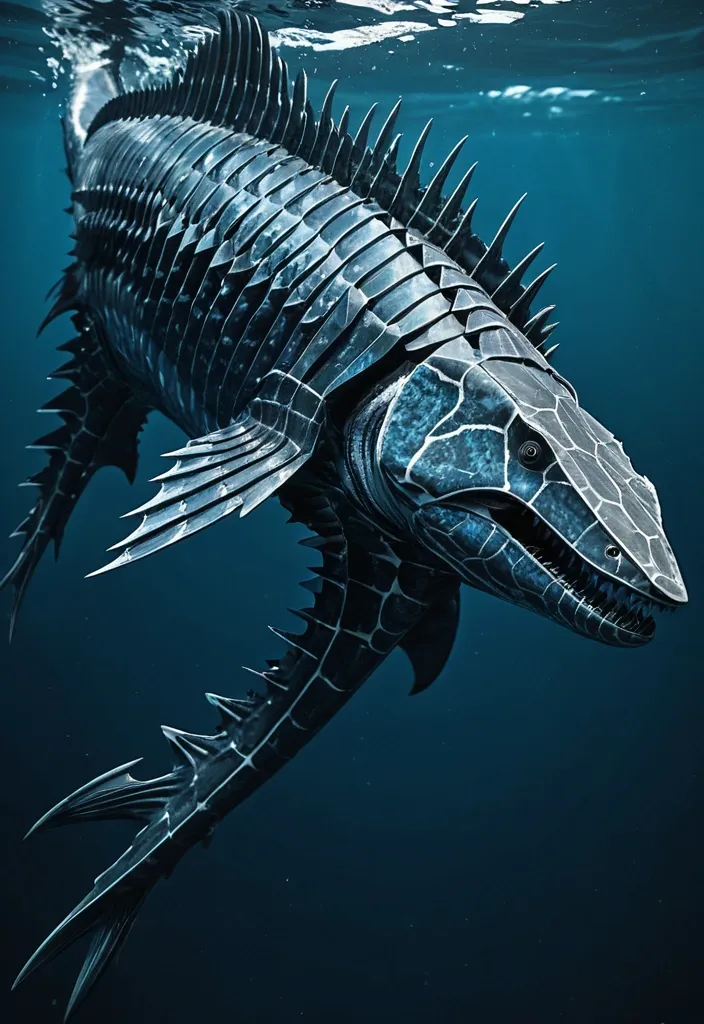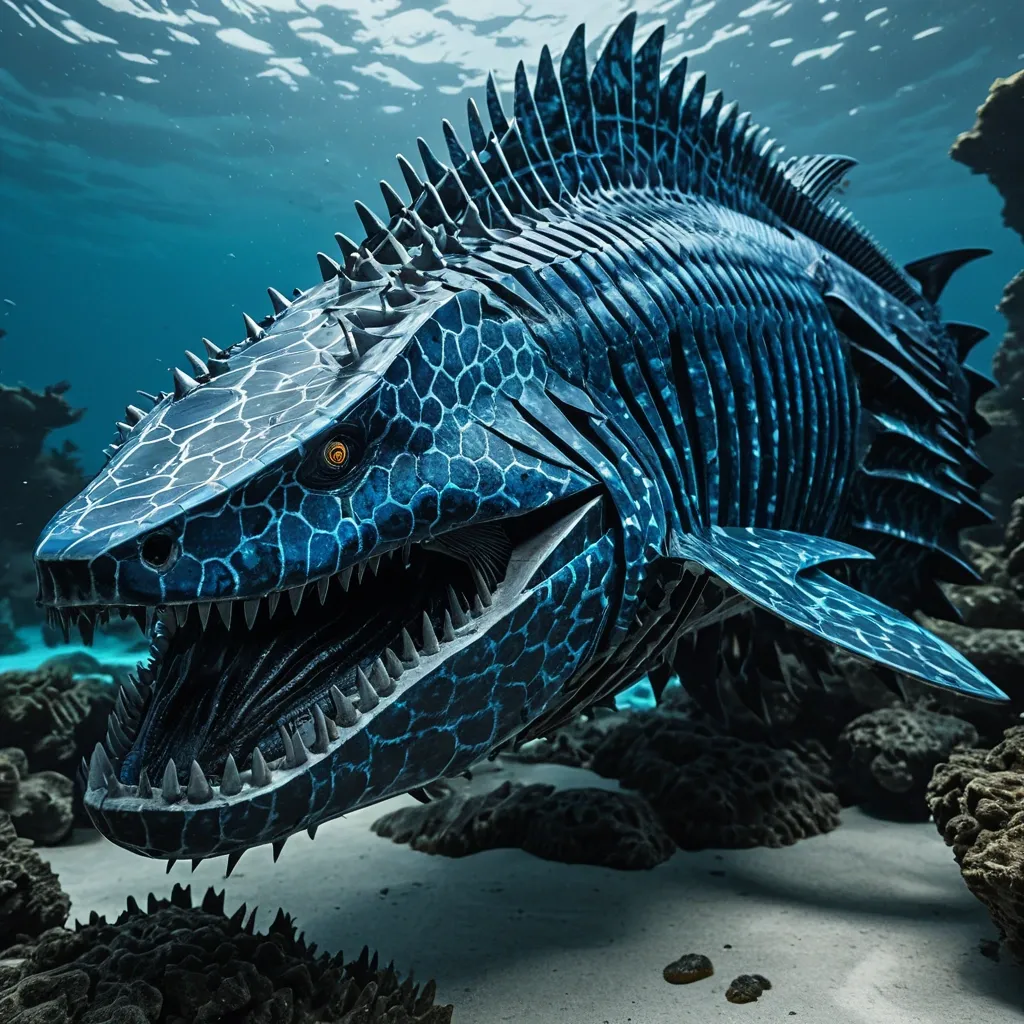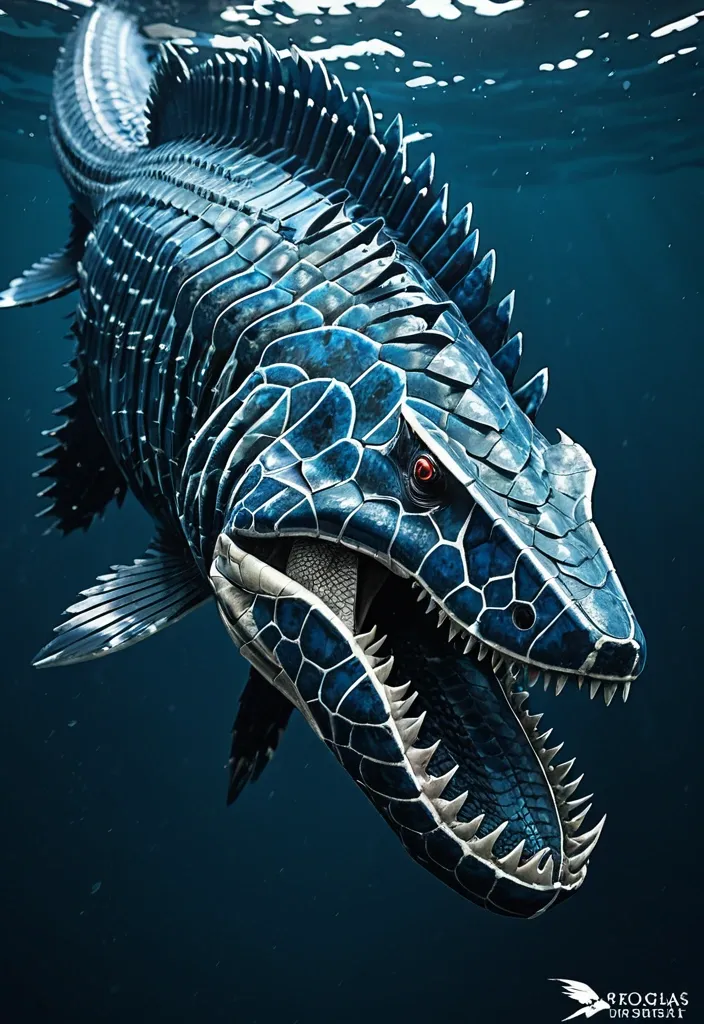Search Results for lined with dozens of large
Explore AI generated designs, images, art and prompts by top community artists and designers.

Orcinus Megalsaurus is a colossal marine hybrid stretching between 40 to 60 feet in length , weighing an imposing 50 to 75 tons. Its body is a streamlined fusion of powerful marine predators and ancient reptiles , designed for both speed and durability. Head & Jaws: Massive and robust jaws reminiscent of Mosasaurus Hoffmannii , lined with dozens of large , serrated teeth capable of slicing through the toughest prey. The jaw muscles are reinforced for crushing power , with an agile , flexible skull allowing it to swallow large creatures whole. Body: Covered in overlapping , bony , and tough Arapaima-inspired scales that provide formidable protection while maintaining flexibility for swift movement. The coloration is a gradient of deep oceanic blues and dark greys , with subtle mottled patterns for camouflage in deep waters. Spines & Armor: Sprouting venomous , long , sharp spines along its dorsal ridge , inspired by the Crown-of-Thorns starfish , these spines serve as both defense and offense , delivering painful , venomous wounds to predators or prey. Flippers & Tail: Enormous paddle-like front flippers derived from Archelon Ischyros , granting powerful swimming strokes. Its tail is flattened and ends in a strong fluke like the Mosasaurus , enabling bursts of speed up to 82 mph , matching the fastest sea animals. The tail's blubber and flexible musculature provide a springlike propulsion effect. Skin & Blubber: Beneath the scales lies a thick layer of dolphin-like blubber , providing insulation , buoyancy , and rapid healing properties. This blubber contains antimicrobial compounds that prevent infection from wounds and smooth the skin for hydrodynamic efficiency. Sensory & Communication: Equipped with the acute echolocation and vocalization abilities of Bigg’s Killer Whales , Orcinus Megalsaurus uses short-range , stealthy communication to coordinate ambush attacks. Its hearing and sonar are highly advanced , allowing it to detect prey at great distances. Mucus Secretion: When threatened , it can release a thick mucus cloud inspired by the Atlantic hagfish , confusing predators and protecting its skin from abrasion and parasites. Locomotion on Land: Although primarily aquatic , it can scoot or slide on land for short distances , using its powerful flippers akin to a leopard seal , allowing it to traverse beaches or shallow coasts. Regeneration: Thanks to the axolotl gene integration , Orcinus Megalsaurus can regenerate lost limbs , spines , and even parts of its internal organs , making it extraordinarily resilient. Abilities: Speed & Agility: Capable of reaching speeds of 45 to 82 mph in short bursts , making it one of the fastest marine predators ever. Its rigid pectoral fins can be tilted back like a black marlin to reduce drag during high-speed chases. Venomous Defense: Venomous spines deter attackers and can incapacitate prey or enemies with painful wounds. Stealth & Teamwork: Utilizes orca-like stealth and coordinated hunting tactics , ambushing prey with precision and communication that avoids detection. Healing & Immunity: Blubber layer accelerates wound healing and provides antimicrobial defense , ensuring survival from injuries sustained during hunts or fights. Mucus Defense: Can deploy mucus clouds to escape or confuse predators and parasites. Environmental Adaptability: Tolerates a wide range of salinity , from freshwater estuaries to deep oceanic waters , allowing it to exploit diverse hunting grounds. ,

Orcinus Megalsaurus is a colossal marine hybrid stretching between 40 to 60 feet in length , weighing an imposing 50 to 75 tons. Its body is a streamlined fusion of powerful marine predators and ancient reptiles , designed for both speed and durability. Head & Jaws: Massive and robust jaws reminiscent of Mosasaurus Hoffmannii , lined with dozens of large , serrated teeth capable of slicing through the toughest prey. The jaw muscles are reinforced for crushing power , with an agile , flexible skull allowing it to swallow large creatures whole. Body: Covered in overlapping , bony , and tough Arapaima-inspired scales that provide formidable protection while maintaining flexibility for swift movement. The coloration is a gradient of deep oceanic blues and dark greys , with subtle mottled patterns for camouflage in deep waters. Spines & Armor: Sprouting venomous , long , sharp spines along its dorsal ridge , inspired by the Crown-of-Thorns starfish , these spines serve as both defense and offense , delivering painful , venomous wounds to predators or prey. Flippers & Tail: Enormous paddle-like front flippers derived from Archelon Ischyros , granting powerful swimming strokes. Its tail is flattened and ends in a strong fluke like the Mosasaurus , enabling bursts of speed up to 82 mph , matching the fastest sea animals. The tail's blubber and flexible musculature provide a springlike propulsion effect. Skin & Blubber: Beneath the scales lies a thick layer of dolphin-like blubber , providing insulation , buoyancy , and rapid healing properties. This blubber contains antimicrobial compounds that prevent infection from wounds and smooth the skin for hydrodynamic efficiency. Sensory & Communication: Equipped with the acute echolocation and vocalization abilities of Bigg’s Killer Whales , Orcinus Megalsaurus uses short-range , stealthy communication to coordinate ambush attacks. Its hearing and sonar are highly advanced , allowing it to detect prey at great distances. Mucus Secretion: When threatened , it can release a thick mucus cloud inspired by the Atlantic hagfish , confusing predators and protecting its skin from abrasion and parasites. Locomotion on Land: Although primarily aquatic , it can scoot or slide on land for short distances , using its powerful flippers akin to a leopard seal , allowing it to traverse beaches or shallow coasts. Regeneration: Thanks to the axolotl gene integration , Orcinus Megalsaurus can regenerate lost limbs , spines , and even parts of its internal organs , making it extraordinarily resilient. Abilities: Speed & Agility: Capable of reaching speeds of 45 to 82 mph in short bursts , making it one of the fastest marine predators ever. Its rigid pectoral fins can be tilted back like a black marlin to reduce drag during high-speed chases. Venomous Defense: Venomous spines deter attackers and can incapacitate prey or enemies with painful wounds. Stealth & Teamwork: Utilizes orca-like stealth and coordinated hunting tactics , ambushing prey with precision and communication that avoids detection. Healing & Immunity: Blubber layer accelerates wound healing and provides antimicrobial defense , ensuring survival from injuries sustained during hunts or fights. Mucus Defense: Can deploy mucus clouds to escape or confuse predators and parasites. Environmental Adaptability: Tolerates a wide range of salinity , from freshwater estuaries to deep oceanic waters , allowing it to exploit diverse hunting grounds. ,

The Megalosaurus Orca is a colossal marine hybrid dinosaur , measuring between 40 to 60 feet in length and weighing an astonishing 50 to 75 tons. Its body combines the robust , thick musculature and mighty jaw strength of Predator X and Megalodon with the sleek hydrodynamics and agility of the Mosasaurus Hoffmannii and transient killer whale. The creature’s skin is armored with large , overlapping bony scales inspired by the Arapaima , offering both flexibility and formidable protection against predators and environmental hazards. Its coloration is sexually dimorphic: males boast a deep black base coat adorned with light gray tiger stripes , while females display a gray base with stark white tiger stripes. Both sexes feature vivid red bioluminescent photophores arranged in tiger stripe patterns along their flanks and dorsal fins , used for communication , intimidation , mating displays , and luring prey in the abyssal darkness. The Megalosaurus Orca’s rigid pectoral fins can tilt back to reduce drag during high-speed pursuits , enabling bursts of speed up to 82 mph , rivaling the Black Marlin and shortfin mako shark. Powerful flippers , inspired by the leopard seal , allow it to scoot or slide short distances on land , useful for navigating beaches and shallow coasts. Its head features powerful jaws lined with dozens of large , long canine teeth capable of delivering over 40 , 000 PSI bite force , capable of crushing almost anything in its path. The skull is flexible , allowing it to swallow large prey whole. Crown-of-Thorns starfish-like venomous spines stud its dorsal ridge , serving as a defensive mechanism against attackers , and it can regenerate lost spines and limbs rapidly , a gift from its axolotl heritage. Abilities: Dual Respiratory System: Equipped with both functional lungs and gills , it can breathe underwater and survive brief excursions on land , as well as thrive at depths from 500 to 9 , 800 feet. Mucus Defense: Inspired by the Atlantic hagfish , it secretes a thick mucus layer that deters parasites and predators while retaining moisture during surface rests or land visits. Blubber Insulation: A thick layer of blubber provides thermal insulation , antimicrobial protection , and aids in rapid healing of wounds. The blubber’s varying stiffness across the body creates a springlike swimming motion , enhancing speed and agility. Stealth Hunting: Utilizing the transient killer whale’s passive listening abilities and silent movement , it stalks marine mammals and large prey with deadly precision , avoiding echolocation to remain undetected. Bioluminescent Communication: Red photophores allow complex signaling in the dark ocean depths for social interaction , mating , and intimidation. Salinity Tolerance: Can thrive in a wide range of salinity levels , from freshwater estuaries to the deep ocean , thanks to genetic traits from Mexican molly and saltwater crocodile. Reproductive Strategy: Live births occur in crushing-pressure depths up to 9 , 800 feet. Offspring are born adapted to extreme cold and pressure. The social group consists of a male and two females , balancing speed/power and endurance/nurturing roles. Behavior and Social Structure: Megalosaurus Orca travel in small , tight-knit family units of three , mirroring the transient killer whale’s social structure. The male leads high-speed hunts , using brute force and stealth , while females provide endurance and care for offspring. They communicate through low growls , barks , and the flashing of their bioluminescent stripes. Backstory: Created by the Ceno Evail Crossgen Corporation , the Megalosaurus Orca was engineered as the ultimate marine apex predator and survivor , blending the most fearsome traits of prehistoric and modern oceanic hunters. Designed to dominate both shallow and abyssal waters , it represents a pinnacle of genetic engineering with a lifespan reaching up to 135 years. Its creation was part of a secret project to explore deep-sea resource harvesting and marine ecosystem control , but its intelligence and adaptability have made it a subject of fascination and caution among researchers. ,

The Megalosaurus Orca is a colossal marine hybrid dinosaur , measuring between 40 to 60 feet in length and weighing an astonishing 50 to 75 tons. Its body combines the robust , thick musculature and mighty jaw strength of Predator X and Megalodon with the sleek hydrodynamics and agility of the Mosasaurus Hoffmannii and transient killer whale. The creature’s skin is armored with large , overlapping bony scales inspired by the Arapaima , offering both flexibility and formidable protection against predators and environmental hazards. Its coloration is sexually dimorphic: males boast a deep black base coat adorned with light gray tiger stripes , while females display a gray base with stark white tiger stripes. Both sexes feature vivid red bioluminescent photophores arranged in tiger stripe patterns along their flanks and dorsal fins , used for communication , intimidation , mating displays , and luring prey in the abyssal darkness. The Megalosaurus Orca’s rigid pectoral fins can tilt back to reduce drag during high-speed pursuits , enabling bursts of speed up to 82 mph , rivaling the Black Marlin and shortfin mako shark. Powerful flippers , inspired by the leopard seal , allow it to scoot or slide short distances on land , useful for navigating beaches and shallow coasts. Its head features powerful jaws lined with dozens of large , long canine teeth capable of delivering over 40 , 000 PSI bite force , capable of crushing almost anything in its path. The skull is flexible , allowing it to swallow large prey whole. Crown-of-Thorns starfish-like venomous spines stud its dorsal ridge , serving as a defensive mechanism against attackers , and it can regenerate lost spines and limbs rapidly , a gift from its axolotl heritage. Abilities: Dual Respiratory System: Equipped with both functional lungs and gills , it can breathe underwater and survive brief excursions on land , as well as thrive at depths from 500 to 9 , 800 feet. Mucus Defense: Inspired by the Atlantic hagfish , it secretes a thick mucus layer that deters parasites and predators while retaining moisture during surface rests or land visits. Blubber Insulation: A thick layer of blubber provides thermal insulation , antimicrobial protection , and aids in rapid healing of wounds. The blubber’s varying stiffness across the body creates a springlike swimming motion , enhancing speed and agility. Stealth Hunting: Utilizing the transient killer whale’s passive listening abilities and silent movement , it stalks marine mammals and large prey with deadly precision , avoiding echolocation to remain undetected. Bioluminescent Communication: Red photophores allow complex signaling in the dark ocean depths for social interaction , mating , and intimidation. Salinity Tolerance: Can thrive in a wide range of salinity levels , from freshwater estuaries to the deep ocean , thanks to genetic traits from Mexican molly and saltwater crocodile. Reproductive Strategy: Live births occur in crushing-pressure depths up to 9 , 800 feet. Offspring are born adapted to extreme cold and pressure. The social group consists of a male and two females , balancing speed/power and endurance/nurturing roles. Behavior and Social Structure: Megalosaurus Orca travel in small , tight-knit family units of three , mirroring the transient killer whale’s social structure. The male leads high-speed hunts , using brute force and stealth , while females provide endurance and care for offspring. They communicate through low growls , barks , and the flashing of their bioluminescent stripes. Backstory: Created by the Ceno Evail Crossgen Corporation , the Megalosaurus Orca was engineered as the ultimate marine apex predator and survivor , blending the most fearsome traits of prehistoric and modern oceanic hunters. Designed to dominate both shallow and abyssal waters , it represents a pinnacle of genetic engineering with a lifespan reaching up to 135 years. Its creation was part of a secret project to explore deep-sea resource harvesting and marine ecosystem control , but its intelligence and adaptability have made it a subject of fascination and caution among researchers. ,

Orcinus Megalsaurus is a colossal marine hybrid stretching between 40 to 60 feet in length , weighing an imposing 50 to 75 tons. Its body is a streamlined fusion of powerful marine predators and ancient reptiles , designed for both speed and durability. Head & Jaws: Massive and robust jaws reminiscent of Mosasaurus Hoffmannii , lined with dozens of large , serrated teeth capable of slicing through the toughest prey. The jaw muscles are reinforced for crushing power , with an agile , flexible skull allowing it to swallow large creatures whole. Body: Covered in overlapping , bony , and tough Arapaima-inspired scales that provide formidable protection while maintaining flexibility for swift movement. The coloration is a gradient of deep oceanic blues and dark greys , with subtle mottled patterns for camouflage in deep waters. Spines & Armor: Sprouting venomous , long , sharp spines along its dorsal ridge , inspired by the Crown-of-Thorns starfish , these spines serve as both defense and offense , delivering painful , venomous wounds to predators or prey. Flippers & Tail: Enormous paddle-like front flippers derived from Archelon Ischyros , granting powerful swimming strokes. Its tail is flattened and ends in a strong fluke like the Mosasaurus , enabling bursts of speed up to 82 mph , matching the fastest sea animals. The tail's blubber and flexible musculature provide a springlike propulsion effect. Skin & Blubber: Beneath the scales lies a thick layer of dolphin-like blubber , providing insulation , buoyancy , and rapid healing properties. This blubber contains antimicrobial compounds that prevent infection from wounds and smooth the skin for hydrodynamic efficiency. Sensory & Communication: Equipped with the acute echolocation and vocalization abilities of Bigg’s Killer Whales , Orcinus Megalsaurus uses short-range , stealthy communication to coordinate ambush attacks. Its hearing and sonar are highly advanced , allowing it to detect prey at great distances. Mucus Secretion: When threatened , it can release a thick mucus cloud inspired by the Atlantic hagfish , confusing predators and protecting its skin from abrasion and parasites. Locomotion on Land: Although primarily aquatic , it can scoot or slide on land for short distances , using its powerful flippers akin to a leopard seal , allowing it to traverse beaches or shallow coasts. Regeneration: Thanks to the axolotl gene integration , Orcinus Megalsaurus can regenerate lost limbs , spines , and even parts of its internal organs , making it extraordinarily resilient. Abilities: Speed & Agility: Capable of reaching speeds of 45 to 82 mph in short bursts , making it one of the fastest marine predators ever. Its rigid pectoral fins can be tilted back like a black marlin to reduce drag during high-speed chases. Venomous Defense: Venomous spines deter attackers and can incapacitate prey or enemies with painful wounds. Stealth & Teamwork: Utilizes orca-like stealth and coordinated hunting tactics , ambushing prey with precision and communication that avoids detection. Healing & Immunity: Blubber layer accelerates wound healing and provides antimicrobial defense , ensuring survival from injuries sustained during hunts or fights. Mucus Defense: Can deploy mucus clouds to escape or confuse predators and parasites. Environmental Adaptability: Tolerates a wide range of salinity , from freshwater estuaries to deep oceanic waters , allowing it to exploit diverse hunting grounds. ,